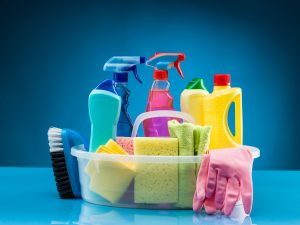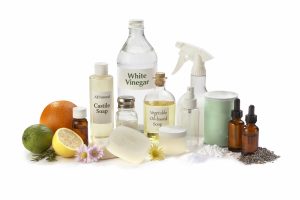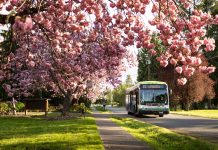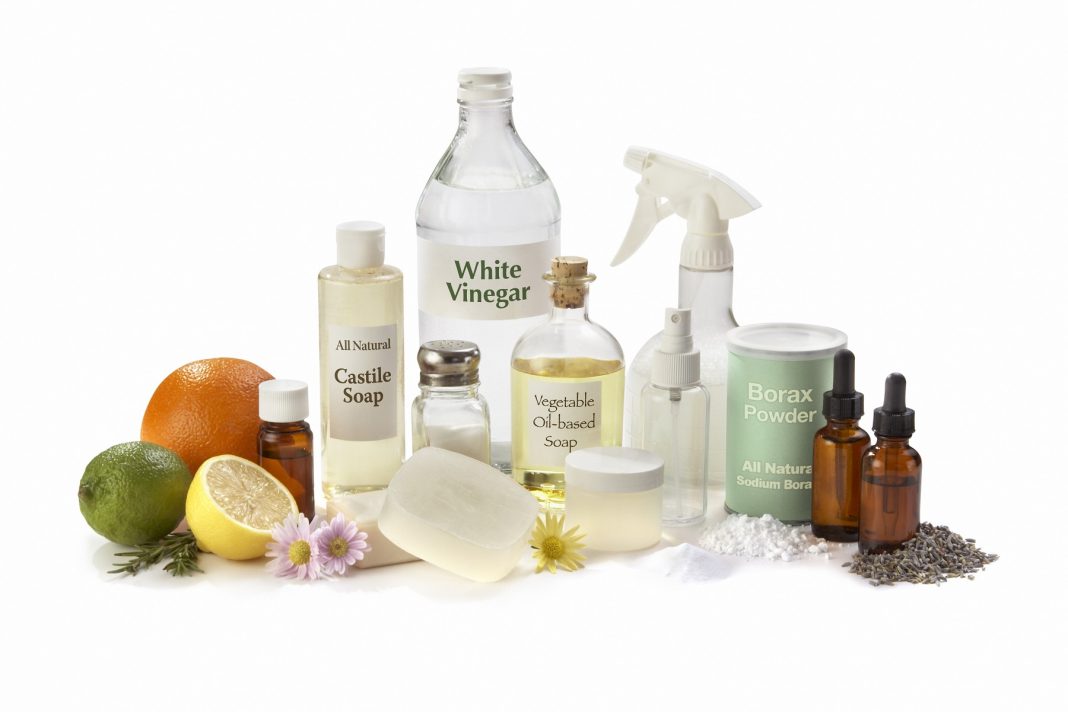I feel like Pacific Northwesters have the corner on spring cleaning. After our wet, muddy, moldy winters, we are ready to come out of hibernation, clean out our homes and get ready to soak up as much sun as possible. To help you keep your family healthy, the WET Science Center and Thurston County Public Health teamed up to give you these tips on spring cleaning with safer products.
Look at the Cleaning Product Labels

Before you start cleaning, look at your cleaning products. Are they safe to use around your family, especially kids and pets? “We suggest that you read labels while still at the store to make sure that the cleaning products that you bring home are as safe as possible,” says Jennifer Johnson, Education and Outreach Specialist with Thurston County Public Health.
Labels reading can be tricky. Have you heard of greenwashing? Product marketing can make them look safer and more environmentally-friendly than they really are. “’Safe,’ ‘non-toxic,’ ‘good for the environment,’ those are not regulated words and may not mean what they say,” warns Johnson. “Don’t be deceived by marketing terms like ‘Green,’ ‘Eco-friendly,’ or having labels with nature-like images.”
The only regulated words are the signal words caution, warning, danger or poison. Avoid products with the signal words danger or poison. Always read the label directions and follow them exactly. If the label says to wear gloves or eye protection, do so! If the label says to use only in a well-ventilated space, open a window and use a fan.
The good news is that there are certifications you can (and should!) look for when choosing cleaning products. “Look for products with the logos ‘Safer Choice’ or ‘Green Seal,’” shares Jihan Grettenberger, environmental educator, at the WET Science Center. “These logos mean that ingredients in the products meet established safety standards for human health and the environment.”
Mold Clean Up
Mold is common in the damp Pacific Northwest. The best way to clean mold is make a paste with a dry detergent and a little bit of water, then scrub clean. To prevent mold, open windows every day and use fans or open a window when bathing or cooking. Keep furniture away from the wall and limit clutter as much as possible. Clean up water leaks as soon as possible and dust and vacuum, weekly.
Dispose of Old Cleaning Products Properly
If you discover you have cleaning or household products that you no longer wish to use, be sure to dispose of them properly. Grettenberger recommends you dispose of these products safely by taking them to Thurston County HazoHouse for free disposal. This includes things like drain cleaner, oil, and lawn and garden products.
Be Aware of Where It Goes!
It’s easy to get caught up in cleaning and not really think about where that cleaner is going. Those on septic systems should be especially aware, as putting the wrong thing down a drain or toilet could be costly and disrupt the processes in your septic system. “For those on a septic system, it is important to use less toxic cleaning products as some chemicals in the products can harm the microbial life in the tank, causing potential system failures,” explains Grettenberger. “The microbes help break down all your waste including toilet paper.”
This doesn’t mean that if you live on city water, you’re all good though. Those products you put down the drain, into your toilet, or even your dishwasher and washing machine, still go “somewhere.” “Whether your wastewater goes to a LOTT Clean Water Alliance treatment plant or somewhere else, what you send down the drain matters,” Grettenberger continues. “While the treatment plant does an effective job at removing human waste, not all of the chemicals in our products are removed in the wastewater treatment process. As a result, trace amounts of chemicals can end up being discharged into Puget Sound.” To learn more about what not to flush, visit the LOTT Clean Water website. We can all help Puget Sound thrive and be a beautiful place to go.So swapping out those harsh cleaning products is good for your family, and also local water quality.
Use the Least Toxic Product That Gets the Job Done

Johnson explains that often, harsher cleaning products are not needed and do not clean any better than the safer alternatives. “Safer products may need a bit more elbow grease to achieve the same results. All that you really need to clean the house safely and thoroughly is: baking soda, vinegar and castile soap,” adds Johnson.
“Mostly what people associate with clean is the smell of a product. Lemon juice works to achieve that smell if people don’t like the smell of vinegar. Open windows every day to get a fresh ‘scent’ safely!”
There are times when you do need to seriously disinfect, especially if you are cleaning up after someone who is sick. “The only times that disinfectants are needed is when cleaning up bodily fluids so avoid them when not needed and use only as directed,” Johnson says. “If you need to sanitize or disinfect, choose products with hydrogen peroxide as the active ingredient and make sure to keep the product wet on the surface for as long as the label says.”
Otherwise, select a safer commercial product or make your own “green” cleaner says Grettenberger.
How To Make a Safe, Green All-Purpose Cleaner
- 1 2/3 cup baking soda
- ½ cup liquid castile soap
- ½ cup water
- 2 tablespoons vinegar
- 16-ounce bottle with flip-top cap
Mix baking soda and liquid soap with a fork in bowl. Add water. Add vinegar last. Pour into squeeze bottle; if too thick, add more water. Shake well. Squirt in tub, sink, toilet, counter, etc. Scrub and rinse.
If you have questions about cleaning options, check out the Thurston County Public Health’s Healthy Home website. The Healthy Homes program offers free home and garden workshops for anyone who is interested in learning more about keeping our families safe and healthy, with topics like air quality, home toxins, lawn care, cleaning and more. You can also learn about our wastewater and ways to help protect Puget Sound by visiting the WET Science Center website.
Sponsored



















































